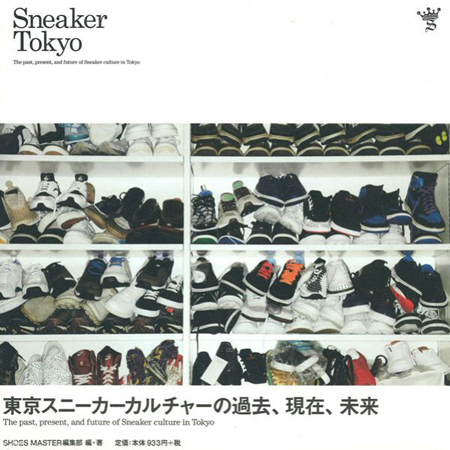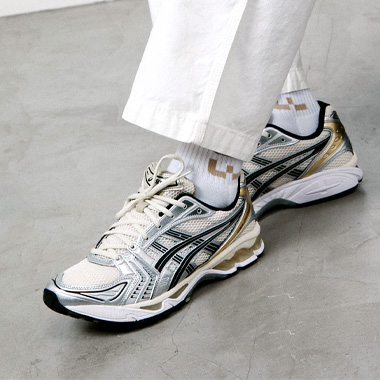Ce livre consacré à la culture Sneakers a été édité par le magazine japonais Shoe Master. Vous y trouverez : 5 années d’archives des meilleurs articles du magazine Shoe Master – des interviews : Hiroshi Fujiwara, Hiroaki Shitano, Shigeyuki Kunii, Hommyo Hidefumi – les nouveaux projets : Adidas, Converse, Dc, Etnies, Gravis, Lacoste, Mad Foot, Onitsuga Tiger, Reebok… le tout dans 180 pages (format 21 x 22) et traduit en anglais. Il est disponible chez Colette et découvrez une partie de l’interview d’Hiroshi Fujiwara dans la suite.

Sneaker Tokyo – Interview with Hiroshi Fujiwara
Any selection made by Hiroshi Fujiwara invariably becomes the subject of much attention, and every project he takes on becomes high profile. Fujiwara has had a profound influence on the sneaker scene. That said, though, Fujiwara himself does not have one pretentious bone in him. He is as natural as they come; not afraid to admit when something is good, and wearing whatever shoes that he wants to wear. There is no changing this style of his.
Hiroshi Fujiwara – you are trend setter in the Tokyo sneaker scene. It seems like you has been the owner of such a reputation for quite a while now, which begs the question, “How has the sneaker scene changed these past few years in your eyes?” Some say that “the sneaker boom has come to and end,” or that the “momentary boom has been lost,” but is this really the case?
What really happened is that the sneaker scene has been broken right open, rather than the boom being over. A long time ago, the picture that was depicted was that “sneakers were a sports brand.” Now however, many luxury brand manufacturers make sneakers; manufacturers of leather shoes even employ the same soles that are used to make sneakers comfortable. So in that respect, I guess we can say that all those things that came about thanks to the sneaker scene have made contributions in various other areas. Not only that, but recently the so-called “gyaruo” regularly wear classic and vintage sneakers, making the sneaker target that much greater than it was before.
Have your tastes changed with time?
No, they really haven’t.
Can you tell us in some detail what time of sneakers you like?
This isn’t just limited to sneakers, but in everything I like to feel a sense of personality in something. I also find myself drawn to things that have a sense of street to them somewhere deep inside. I also really like sneakers that are extremely light or extremely easy to wear. Basically, I guess anything that just has an “extreme” sense to it. As for which brands I like, of course I love Nike, Adidas, New Balance, Converse and visvim too. Since I’m not a contracted professional athlete, I don’t really have any particular bias when it comes to brands. As far as design is concerned, I like designs that are very simple. That said, though, at times I really get in the mood to wear these though high-tech sneakers.
Where does that desire stem from?
That’s a difficult question. Moods are moods, you know (he laughs).
Do you continue to search for certain sneakers?
I do, but certainly not as much as I used to. I’ll go to stores, or I’ll check the new product line-ups at homepages of brands like Nike. I also check Yahoo! Auction to see if there isn’t anything there that might interest me (he laughs).
So, I guess that the internet has become an essential element of the sneakers culture.
Well, the internet has its good points, but it has also made certain aspects a bit more dull. While it’s great that it’s now easier to get that particular pair of sneakers you want, on the other hand, that special excitement of treasure hunting has been lost.
That’s complicated, huh. Especially in the 90s when treasure hunting for sneakers was the best part.
That’s right. Back then it wasn’t about buying a pair, selling it and then making a profit. It was simpler then; it was just about being happy that you got the pair you wanted.
By the way, after developing a relationship with Nike, you went from “one of sneaker fan” to “manufacturer’s side.” When your position changed, did the way you view sneakers change along with it?
No, the way I feel about sneakers has not changed. What has changed, though, is that if there is a particular kind of sneakers that I want recreated I approach Nike and we get them back out there. Also, I get to wear those sneakers which I helped design and choose a color for quicker than anybody else (he laughs).
Is there something you want to say (or something you’d like to ask for) to the sneaker industry or to sneaker manufacturers?
Nowadays, no matter where you go you see the same sneakers in all the stores. I’d like to tell the industry that perhaps they should rethink this. Wouldn’t it be nice to be able to bring out a bit more “local flavors” in sneakers? But that’s something I’ve been saying for quite a while now.
Is the globalization that is happening with sneakers making the sneaker culture less exciting?
This is not just limited to sneakers. It can be seen with all luxury brands. The Louis Vuitton Sprouse, for instance. If it were sold only in NY, then people who really want one would have to come all the way to NY to buy it. For sneakers it would be like saying that products thought up and sold in Japan’s ‘NSW STORE,’ would get offers from around the world saying things like, ‘hey, we want to sell this product too.’ But, I feel that to a certain extent this should be restricted, by answering that, ‘This is only for Japan. You should try to design your own products.’ Rather than working to make the company bigger, it would be far more interesting if, for instance, the relationship between Nike Japan and nike France had a bit more rivalry to it.
I agree
Well, yeah, then it would be sort of like a friendly rivalry with each of them independently making their own things. But then again, bringing out that local flavor is quite difficult. It’s not like just because the shoe is made in Japan, you would use kanji or hiragana (the Japanese alphabets). It’s also not about bringing out cheesy local qualities either.
One previous example of how local flavor was added to a product, I guess, is the HTM, which could not be purchased unless the person went to Head Porter and AD21. I think that’s what you mean about the fundamental excitement of sneakers treasure hunting.
Well, if something can only be purchased at a particular store, people will absolutely want to go all the way to the store, right. For instance, there are no plans to sell this yellow Footscape here (of which there are only samples at this point) in Japan. So if you want a pair, you need to go overseas.
So, it’s not sold in Japan, huh. I guess diehard sneaker-freaks love hearing these words (he laughs).
Personally, I also sometimes buy these ‘Not Sold in Japan’ sneakers when I’m overseas. Or even when I’m not really sure if they are actually sold in Japan, but I know that they are not very well known about here. Like the Hyperdunk, for example.
By the way, what about shops in Tokyo. The number of sneakers shops in Harajuku has decreased compared to a while ago. But on the other hand, mega shops such as ABC-MART and ASBee have emerged and are increasing their number of stores nationwide.
I go to ABC-MART, too. I recently bought a pair of Converse there – dark blue, hi-cut All Star Converse.
Hiroshi Fujiwara and ABC-MART – I just don’t see it
When it comes to these extremely basic sneakers like the All Star Converse you can be sure that ABC-MART will have some in stock. You sort of get that sense of reassurance, don’t you? These big shops like ABC-MART have something good about them that smaller shops – frequented by sneaker freaks – just dont have. By the way, last year I bought a pair of Nike Footsteps at the Ise JUCSO.
JUSCO? Hiroshi Fujiwara and JUSCO are another combination I never thought i’d hear (he laughs).
If you see products in places like this, you’re often more likely to get a new perspective on the whole thing. It was there that I first learned that the purple Footscapes had been release.”
That makes sense. So, you make these unusual discoveries in unusual places. Now, lastly I’d like to ask you what you see happening with the Tokyo sneaker culture – a mature culture.
I believe that the sneaker culture itself will continue. However, what style it will take on, is an entirely different matter.
Do you see any big waves being made like the Air Max 95?
No, I don’t think we’ll never see that again. That was a completely natural and spontaneous wave that the company was not expecting. Now you see companies trying to create such a wave, but this quite difficult as it needs to be something that takes hold in the streets. Such a street influence is extremely important to the sneaker culture. It’s less about which actor or musician is wearing the shoes, than it is about seeing a person on the street wearing them and thinking that they look cool and that you’d like to own a pair. This is how these waves slowly start to spread. I think that the fact these movements begin in the streets in very typical of Tokyo.
Itw : HB


